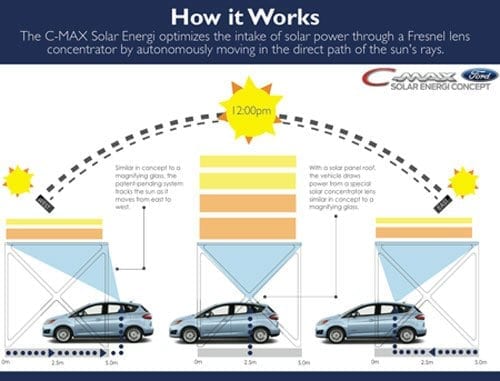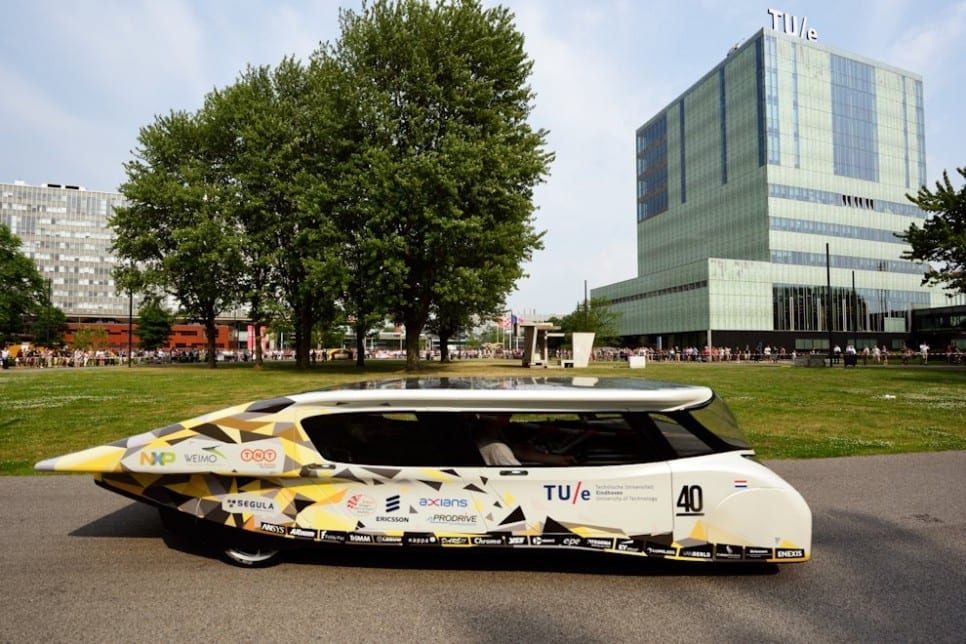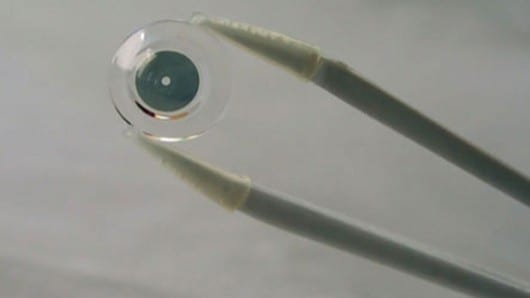
Would be the first mass-produced, commercially available automobile to offer drivers the ability to recharge a depleted battery via solar power or by plugging into an outlet.
Solar-powered cars have been little more than a novelty to date, experimental vehicles resembling photovoltaic-laden surfboards designed mostly for racing across deserts. Expensive batteries, relatively inefficient PV energy conversion and the lack of intense sunlight in many places have made sun-powered passenger vehicles impractical.
Ford is looking to change that with a version of its plug-in hybrid C-MAX Energi that would allow drivers to charge the hatchback’s lithium-ion battery via PV panels mounted on the roof. Other carmakers already sell models that use solar cells to power cabin ventilation (Toyota) or accessories (Nissan). The C-MAX Solar Energi Concept—which Ford will showcase at next week’s International Consumer Electronics Show (CES) in Las Vegas—would be the first mass-produced, commercially available automobile to offer drivers the ability to recharge a depleted battery via solar power or by plugging into an outlet.
The recharging process gets a boost when the solar C-MAX is parked under an accompanying 20-square meter acrylic canopy equipped with 20 Fresnel compact lenses—the kind used in lighthouses—that act as a giant magnifying glass, directing intense rays to the car’s solar panels. Used in tandem over the course of six to eight hours, the rooftop solar cells and concentrator canopy would fully recharge the car’s battery, which can power the car for up to 34 kilometers before the hybrid’s gasoline engine needs to kick in.
Further improving solar-charging efficiency, the new C-MAX would use sensors and cameras to track the sun’s position and autonomously reposition the car for optimal sunlight exposure. Ford already offers this technology to help drivers maintain a pre-set distance from the vehicle in front of them (via adaptive cruise control), stay in their lane and avoid vehicles in their blind spots. The C-MAX Solar would use these capabilities when parked under its canopy to automatically roll up to 2.5 meters forward or backward as the sun shifts in the sky. The combined canopy and tracking system will enable the car to charge up to eight times faster than simply parking the solar-powered car in the sun, says Mike Tinskey, Ford global director of vehicle electrification and infrastructure.
The Latest on: Solar-powered cars
[google_news title=”” keyword=”Solar-powered cars” num_posts=”10″ blurb_length=”0″ show_thumb=”left”]
via Google News
The Latest on: Solar-powered cars
- Brother of Nuggets' Porter Jr. arrested on DWIon May 1, 2024 at 7:54 pm
Students in Denver built a solar-powered car and have plans to drive to the Kansas border this weekend. FOX31's Ashley Michels caught up with the inventors to learn about their project. Reminder: ...
- Eco-Friendly Speed: How Solar Technology is Changing Motorsportson April 30, 2024 at 4:50 am
In recent years, solar technology has carved a significant niche across various industries, revolutionizing energy consumption patterns worldwide. From small-scale residential projects to massive ...
- Can an electric car be charged with solar power? know howon April 29, 2024 at 6:00 am
Electric vehicles (EVs) have emerged as a promising solution to combat climate change and reduce dependence on fossil fuels. One intriguing ..|News Track ...
- The Future of Driving: Exploring the Latest Advancements in Automotive Technologyon April 29, 2024 at 2:35 am
Buckle up and get ready to take a thrilling ride into the future of driving! In this blog post, we will dive deep into the latest advancements in automotive technology that are revolutionizing the way ...
- Here’s why electric cars are not yet popular in South Africaon April 28, 2024 at 1:00 am
Petrol prices have made many South Africans fantasise about buying an electric car. But there is a reason they’re not yet popular.
- The Myths And Truths About Why Electric Cars Don't Have Solar Panelson April 25, 2024 at 7:00 am
Although solar energy alone cannot fully power a car for real-world usage, manufacturers are overcoming challenges and getting closer by the hour.
- NASA Rover Reaches Promising Place to Search for Fossilised Life on Marson April 24, 2024 at 9:56 am
While we go about our daily lives on Earth, a nuclear-powered robot the size of a small car is trundling around Mars looking for fossils.
- Finding Out The World’s Most Aerodynamic Carson April 21, 2024 at 11:38 pm
In the quest for fuel efficiency and reduced emissions, carmakers have turned their attention to aerodynamics. One standout from the past is Ford’s Probe V concept car, setting the standard with its ...
- Two Cousins Built This "Solar-Powered" Ford F-150 Lightningon April 21, 2024 at 12:59 pm
EV manufacturers promised their rides would help us fight global warming. As it often happens, there was some fine print we shouldn't have ignored ...
- No, diesel generators for charging electric vehicles aren't popping up everywhereon April 17, 2024 at 7:24 am
Edwards explained that eventually he expected such a machine could be replaced by a solar-powered charging station, especially as charging stations became more prolific and electric cars improved ...
via Bing News










